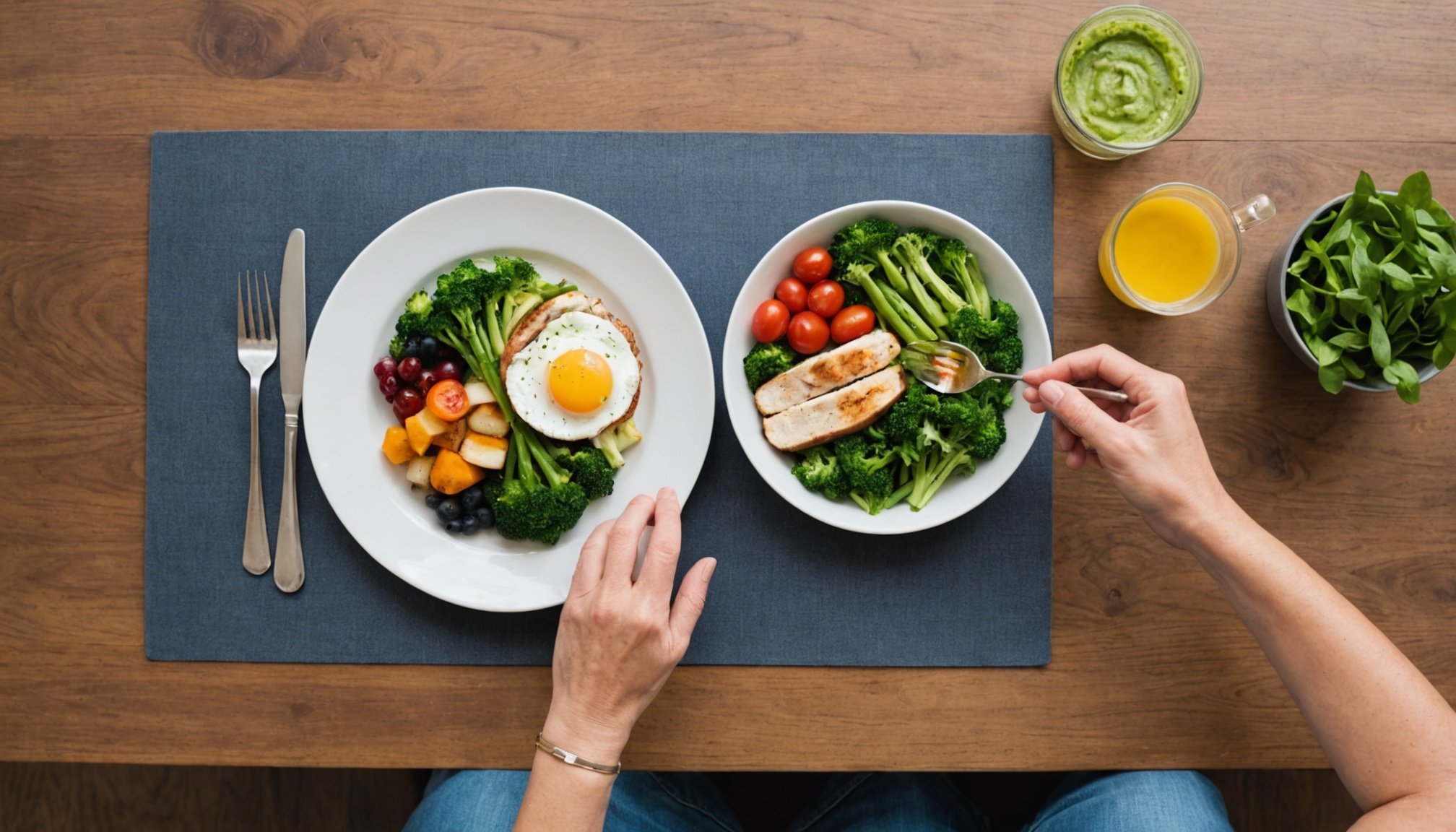Eating mindfully can significantly impact your health, but distractions often lead to overeating. A portion control mat can transform your dining experience. This simple tool encourages you to serve appropriate portions, fostering awareness of your eating habits. By using visual cues to guide your choices, you'll likely develop a healthier relationship with food. Discover how incorporating this mat into your meals can help you savor every bite while reducing waste and excess consumption.
Understanding Portion Control Mats
Exploring the benefits of mindful eating and nutritional tools
Also to read : Enhancing Culinary Comfort: The Impact of Cooktop and Oven Alignment on Ergonomics and Healthy Eating Habits
Portion control mats are innovative tools designed to help individuals manage their food intake effectively. These mats are marked with sections that guide users in serving the right amounts of different food groups. By visually representing appropriate serving sizes, they simplify the process of maintaining a balanced diet.
In today's fast-paced world, the importance of portion control cannot be overstated. Overeating is a common issue in modern diets, often leading to health problems such as obesity and heart disease. Using portion control mats encourages individuals to be more conscious of their eating habits and make healthier choices.
Also to read : Exploring the Impact of Kitchen Window Placement on Your Dining Routine and Habits
Mindful eating is another significant benefit of these mats. By promoting awareness of what and how much one is eating, they help users develop a better relationship with food. This practice can reduce mindless snacking and overeating, contributing to overall well-being.
Here are some advantages of portion control mats:
- Encourage balanced meals
- Reduce food waste
- Support weight management
- Enhance mindful eating practices
By incorporating nutritional tools like these mats into daily routines, individuals can enjoy a more structured and health-conscious approach to eating.
Benefits of Using a Portion Control Mat
Exploring how portion control mats can transform eating habits
Reducing calorie intake is a primary advantage of using a portion control mat. By offering a visual guide, these mats help individuals avoid the common pitfall of overeating. When food portions are clearly defined, it becomes easier to resist the temptation to serve more than necessary, effectively keeping calorie consumption in check.
Encouraging balanced meal composition is another significant benefit. Portion control mats are often designed with sections for various food groups, ensuring that meals are not only well-portioned but also nutritionally diverse. This structure supports individuals in creating meals that are both satisfying and healthful, contributing to overall health improvements.
From a psychological perspective, the act of visually portioning food can promote a sense of control and mindfulness. This can lead to a more positive relationship with food, reducing anxiety around eating and fostering healthier habits. As one user noted, "Having a clear visual of my meal portions has transformed how I approach food."
By integrating these mats into daily routines, individuals can experience a range of benefits, from improved eating habits to enhanced health improvements.
How to Use a Portion Control Mat Effectively
Mastering the art of balanced eating through practical guidance
Setting Up Your Dining Space
Creating an optimal dining space is crucial for effective usage of a portion control mat. Start by clearing the table of unnecessary items to focus solely on your meal. Ensure that the mat is placed at the center of your eating area, providing a clear visual guide for meal planning. This setup encourages a mindful eating experience.
Portion Sizes for Different Food Groups
Understanding portion sizes is essential. Use the mat's sections to allocate space for different food groups. For example, fill half the plate with vegetables, a quarter with protein, and the remaining quarter with whole grains. This balanced approach supports diverse dietary needs and promotes health improvements.
Incorporating the Mat into Daily Meals
Integrating the mat into daily routines can enhance its practicality. Here are some tips:
- Plan meals in advance to ensure balanced nutrition.
- Use the mat as a guide when preparing meals for the week.
- Adjust portions based on specific dietary requirements.
By following these practical tips, individuals can maximize the benefits of a portion control mat, leading to improved eating habits and better health outcomes.
Personal Experiences and Testimonials
Exploring real-life success stories and overcoming challenges in mindful eating
Real-Life Testimonials
Many users have shared their mindful eating journey through portion control mats. For instance, Jane, a working mother, noted how these mats transformed her family's eating habits: "By using the mat, we reduced our portion sizes and started eating more balanced meals." Such user testimonials highlight the positive impact on eating habits.
Case Studies of Success
Several case studies demonstrate the effectiveness of portion control mats. One study involved a group of individuals aiming for healthier lifestyles. After three months, 80% reported improved health outcomes. These success stories underscore the mats' role in promoting balanced nutrition and weight management.
| Case Study | Duration | Outcome |
|---|---|---|
| Study A | 3 months | 80% improved health |
| Study B | 6 months | 90% weight management |
Overcoming Challenges
Despite the benefits, users face challenges in their mindful eating journey. Common issues include initial resistance to change and difficulty in maintaining consistency. However, these challenges can be overcome by setting realistic goals and regularly revisiting user testimonials for motivation. This approach fosters a sustainable relationship with food, as evidenced by numerous success stories.
Comparison with Other Mindful Eating Strategies
Exploring alternatives and their effectiveness in mindful eating
Overview of Popular Mindful Eating Techniques
Mindful eating encompasses various strategies aimed at fostering healthier relationships with food. Popular methods include portion control mats, intuitive eating, and mindful meal journaling. Each technique offers unique benefits, catering to different preferences and lifestyle needs.
Strengths and Weaknesses of Portion Control Mats vs. Other Methods
Portion control mats provide a tangible, visual guide, making them particularly effective for individuals who prefer structured eating. However, they may lack the flexibility offered by intuitive eating, which encourages listening to one's body signals. Mindful meal journaling, on the other hand, promotes reflection and awareness but can be time-consuming.
| Method | Strengths | Weaknesses |
|---|---|---|
| Portion Control Mats | Visual guidance, structure | Less flexibility |
| Intuitive Eating | Flexibility, body awareness | May lack structure |
| Meal Journaling | Reflection, awareness | Time-consuming |
Integrating Multiple Strategies for Optimal Results
Combining different mindful eating techniques can enhance overall effectiveness. For instance, using portion control mats alongside intuitive eating can offer both structure and flexibility. This integration allows individuals to enjoy the benefits of multiple strategies, promoting a more holistic approach to mindful eating.
Scientific Research Supporting Portion Control
Exploring the evidence behind portion control effectiveness
Summary of Research on Portion Sizes and Eating Behavior
Scientific studies have extensively explored the relationship between portion sizes and eating behavior. Research consistently shows that larger portions lead to increased food intake, often without the eater's conscious awareness. This phenomenon underscores the importance of portion control in managing dietary habits.
Impact of Visual Cues on Eating Habits
Visual cues, such as those provided by portion control mats, significantly influence eating habits. Studies indicate that visual guidance helps individuals better estimate appropriate serving sizes, leading to reduced calorie consumption and improved dietary balance. Nutrition experts emphasize that these visual aids can be particularly effective in fostering mindful eating practices.
Insights from Nutrition Experts on Portion Control Effectiveness
Nutrition research highlights the effectiveness of portion control as a tool for weight management and health improvement. Experts agree that by incorporating visual cues, individuals can develop a more structured approach to eating. According to Dr. Smith, a leading nutritionist, "Visual aids in portion control provide a simple yet powerful method to help people eat more healthily."
| Research Focus | Findings |
|---|---|
| Portion Sizes | Larger portions increase food intake |
| Visual Cues | Improve estimation of serving sizes |
| Nutrition Expert Views | Support structured eating habits |
Psychological Aspects of Mindful Eating
Exploring the mental framework influencing eating habits
Understanding the Psychology Behind Overeating
The psychology of overeating often involves emotional triggers and habitual behaviors. Stress, boredom, and emotional distress can lead individuals to consume more food than necessary. Recognizing these behavioral insights is crucial for addressing the root causes of overeating.
Role of Mindfulness in Changing Eating Behaviors
Mindful eating encourages individuals to focus on the present moment, promoting a deeper awareness of hunger cues and food satisfaction. This practice can significantly alter eating behaviors by reducing impulsive eating and fostering a healthier relationship with food. Mindfulness helps individuals pause and consider their eating behaviors, leading to more intentional choices.
Tips for Cultivating a Mindful Eating Mindset
Developing a mindful eating mindset requires practice and patience. Here are some tips to get started:
- Pause before meals to assess hunger levels
- Savor each bite, focusing on taste and texture
- Reflect on emotional states before eating
- Set realistic goals for mindful practices
Implementing these strategies helps individuals become more attuned to their psychological responses to food, ultimately supporting healthier dietary habits. By understanding the interplay between psychology and mindful eating, individuals can make informed decisions that enhance their overall well-being.
Visuals and Examples of Portion Control Mats in Use
Exploring the practical application of visual aids for mindful eating
Images of Portion Control Mats with Example Meals
Visual aids play a crucial role in understanding and implementing portion control. By showcasing meal examples on these mats, users gain clarity on how to distribute food groups effectively. Imagine a mat with sections labeled for proteins, grains, and vegetables, each filled with a colorful and balanced meal. This visual representation not only guides portioning but also inspires creativity in meal preparation.
Tips for Meal Presentation Using the Mats
Presenting meals attractively can enhance the mindful eating experience. Here are some tips:
- Use vibrant vegetables to add color to your plate.
- Arrange food symmetrically to create a pleasing aesthetic.
- Keep portion sizes within the mat's guidelines to maintain balance.
These tips leverage the visual aids of the mat to encourage thoughtful eating practices.
Benefits of Visual Meal Planning for Mindful Eating
Visual meal planning provides numerous benefits for those pursuing mindful eating. It reduces guesswork, ensuring that meals are balanced and nutritionally diverse. As one nutritionist stated, "Seeing your meal laid out visually can transform your approach to food, making it easier to make healthier choices." This approach fosters a structured and satisfying dining experience.
Additional Resources for Mindful Eating
Exploring comprehensive tools and support for enhanced eating habits
Recommended Books and Articles
For those eager to delve deeper into mindful eating, numerous resources offer valuable insights. Books such as "Mindful Eating: A Guide to Rediscovering a Healthy and Joyful Relationship with Food" provide foundational knowledge. Articles in nutrition journals further explore the psychological and practical aspects of portion control. These resources empower readers to make informed decisions and foster healthier eating habits.
Online Communities and Support Groups
Engaging with online communities can be a powerful way to sustain mindful eating practices. Platforms like Reddit and specialized forums host discussions where individuals share experiences and strategies. Joining a support group offers encouragement and accountability, essential for those navigating their mindful eating journey.
Tools and Apps Complementing Portion Control Mats
Numerous tools and apps can enhance the use of portion control mats. Apps like MyFitnessPal and Yazio offer meal tracking and nutritional analysis, complementing the visual guidance of mats. These digital resources provide users with a comprehensive approach to managing their dietary habits. By integrating technology with physical tools, individuals can achieve a balanced and structured eating routine.













